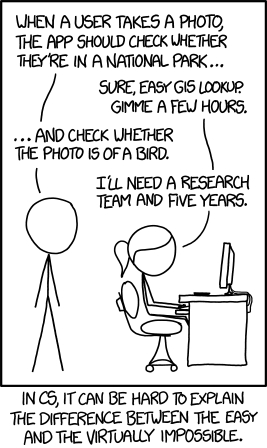Teaching myself OpenCV 2 in 24 hours because I am NOT a masochist
2 MTG related projects in a row! I should get a therapist

Current mental state (c) xkcd guy
Do you ever get so lazy you start a college thesis level project? yeah, me too.
Originally, the plan was to hack Delver Lens onto a raspberry pi (with a few motors) in order to shuffle through cards and create a list. Immediately after inventing that plan, I realized a few things.
- I don’t actually have a practical way to use a list of cards.
- I would still need to sort through them to find what I need, even if I knew that I had them.
- Still useful to know what I have or don’t have, but significantly less useful than a way to access them.
- I have no idea how to write image recognition software.
- yeah… I probably should have thought of that first.
- I have no idea how to mechanically move cards without very high risk of damage
- which sucks when cards can cost easily hundreds of dollars.
- and because I’m an engineering student and I really should know how to do this.
so… yeah. Problems.
The First Solution
or: I can’t write transitional paragraphs
After thinking about this for a while, I finally settled on the idea that the robot would have to not only move cards from pile A to pile B, but also from pile A to pile C. This way, I could use a sort of linear half-selection sort by physically moving the cards from pile to pile.
This does have an efficiency of O(kn), where k is the number of values in [S]∩{min([S])…max([S])} given that S is any given stack of values with repetition. This would be considerably faster if I could swap cards in place, but unfortunately a stack of cards is a LIFO queue and there is not anything I can do about that.
b = []# random list of numbers (a la numpy.randint(0, 1000, 10000))
a = []
c = []
cycles = 0
while (a!=b):
c.insert(0, b.pop(0))
for i in b:
if i != c[0]:
a.insert(0, i)
cycles += 1
else:
c.insert(0, i)
cycles += 1
b = []
for i in a:
if i != c[0]:
b.insert(0, i)
cycles += 1
else:
c.insert(0, i)
cycles += 1
a = []
code to simulate sorting through cards (this took me an embarassingly long time to write) O(nk) would be bad in most instances, but for the limitations, I think it’s fine.\
The Second Solution
or: i love you opencv <3
This turned out to be a little less problematic than I thought it was. I have a lot of python experience (my first engineering project was a RasPi-based robot) so I originally thought to use Tensorflow and train an AI to recognize cards by artwork. The more I thought about this, though, the worse of an idea it became. AI is very good at approximation (i.e “[this] is A Magic Card or [this] is A Vegetable) but it’s not very good at specifics.
My first idea was to use template matching in order to find an image of the card inside a larger image.
ELI5 explanation: Pattern matching is the process of finding the location of a small image inside a larger image. Think of it like printing the small image on plastic wrap and moving it over the larger image until it lines up.
This isn’t a good way of doing this, though. Pattern matching can be very finnicky in situations with bad lighting conditions, scaling, or any amount of rotation, all of which are problems that will occur in this project. Luckily, I figured this out before i spent a week on it.
After dropping that idea, I found Keypoint detection, which is for all intents and purposes Actual Magic.
ELI5 explanation: Keypoints are dark points in an image that are surrounded by lighter points. If two images have a large number of identical keypoints, it’s very probable that they are the same.
ELI15: Keypoints are calculated by choosing a low brightness pixel, then searching the 16 closest pixels to it for brighter colors. If two keypoints have the same light - dark pattern, they are considered to be identical. When comparing images, larger numbers of identical keypoints mean a higher chance that one image contains the other.
The only problem with this approach is that calculating a large number of keypoints takes a very large amount of processing power and time; and in a game with 65 thousand unique cards, even 100 milliseconds of processing time becomes almost 2 hours to brute force.
The current state of this project
or: i have spent too much time on this to give up
Currently, I have three ideas on how to improve the detection time.
- Train a neural net to identify card colors
- This will allow me to divide the saved keypoints by color and cut the time by approximately 85 percent
- However, this would have to have 100% accuracy to be strictly better.
- Use a text recognition neural network to identify card names
- Only the first few characters have to be actually recognized in order to significantly reduce the processing time
- This could be very difficult, since the magic font is both very weird and variable over time.
oh yeah i forgot the robot part
probably just gonna put a cam on a servo and turn it left or right to flick cards into piles, then use worm gears to move the stacks up and down.
it’s stupid but it works.
2-AM-ily, Crinfarr@1200 lines of code